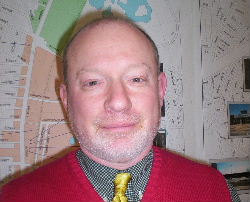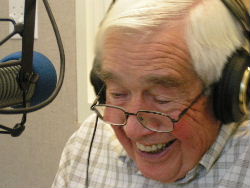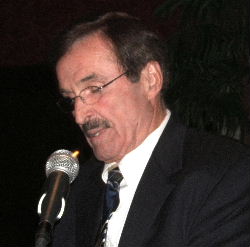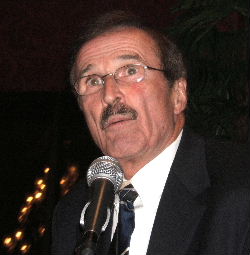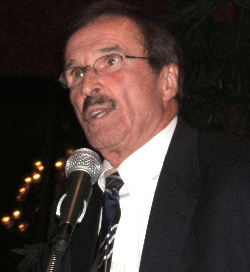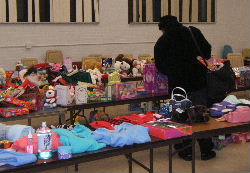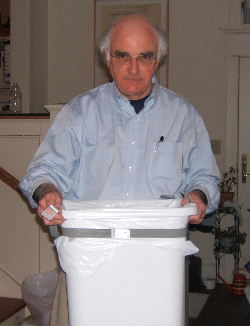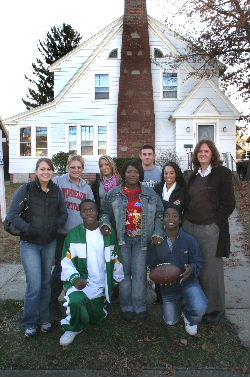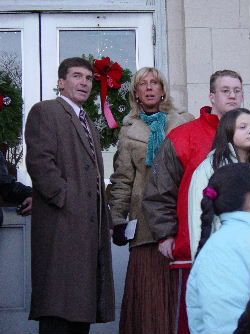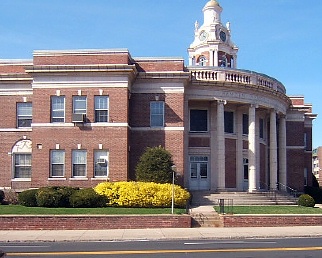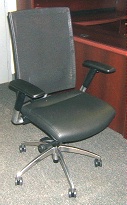 |
|
By Sharon Bass
New Year's resolutions are pointless, IMHO. I've never met anyone who has kept one for more than a day or a week. For some reason, some think Jan. 1 is a magical day when their bad habits and addictions will vaporize effortlessly.
Jan. 1 is really just another day -- a man-designated day -- and has no significance except it marks the beginning of the year on many calendars. So instead of asking a handful of pivotal Hamden figures what their resolutions are, the HDN asked what they'd like to see happen in the world around them over the next 12 months. We asked about a dozen or so people, but admittedly didn't give them much time to reply. This is what came back.
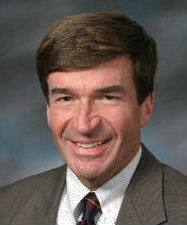
"Globally, I'd hope to see more peace in the world. On the national level, I would like to see more cooperation between the branches of government and less partisan politics. With regard to Connecticut, I'm hoping Susan Bysiewicz rethinks her decision not to run for governor. Locally, I'm hoping to make good on my campaign promises and work successfully with each Legislative Council member. This will, of course, require me to let Curt Leng make all administrative appointments and drive Ron Gambardella to and from Council meetings in a 2006 Ford Explorer." Mayor Craig Henrici, lawyer
"My wishes for the New Year are to bring the troops home from Iraq and
start building communities and creating jobs in the USA." Economic Development Director Dale Kroop

"I am hopeful for a responsible and conscientious administration that works for the best interest of the town, regardless of their party affiliation. We need to put party affiliations aside and work for the taxpayers, not just for our political parties. I hope that the mayor and the Council do not use the revaluation to help pass a stealth tax increase. The Republican Party is the loyal opposition, and we will continue to support our Republican officials to continue to have a balance within town government. I am hopeful for a bright future for Hamden." Republican Town Committee Chair Mike Iezzi, Hamden businessman
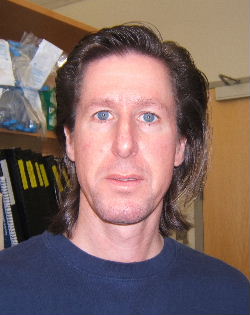
"On the national level, I hope that our government realizes that education is an urgent security issue and deserves more standards and funding. I would like to see the 'No Child Left Behind' model scrapped in favor of a system that directs funding to where it is needed instead of punishing schools with problems. I also wish that Congress and the White House would put as much effort into research and investment into alternative energy sources as they have into trying to pump the last bit of oil out of Alaska.
"On the state level, I hope the Legislature addresses the huge educational inequities that result from funding education primarily from property taxes. The quality of a child's education in Connecticut shouldn't depend on zip code. And on a local level, I would like to see our leaders put divisiveness behind them and work to do what's best for Hamden. For our schools, I would like to see improved relationships between the Board of Education, administration, teachers and staff and parents. Education is too important for our future to fail to provide our time and resources." Hamden PTA President Tim Nottoli, Yale medical researcher
Happy New Year, Hamden. Let's make it a clean and honest one. But whatever, you'll read about it in the HDN.
-----------------------------------------------------------------------------
By Sharon Bass
It was a first of its kind for the Hamden PD yesterday when they raided Urban Clothing at 897 Dixwell Ave. and seized 4,000 pirated CDs. The crime is a felony.
"It's the first time we've focused an investigation on this type of crime," said Deputy Chief Tom Wydra.
Stacey Houston, 37, of New Haven and owner of Urban Clothing, was arrested at 1 p.m. for manufacturing, distributing and selling music CDs. Wydra said the crime is a felony because over 1,000 CDs were confiscated. Houston was allegedly burning them in the store's basement and selling them for $5 apiece.
He was released on $2,500 bond and his store, which sells other stuff like clothes, is open for business.
Wydra said the department received information about the pirated CDs and an investigation by the street crime unit and the Music Industry Association of America ensued. The industry loses between $300 million and $500 million a year because of people like Houston, he said.
The deputy chief said he didn't know how long Houston had been selling the illegal CDs. He's due in Meriden Superior Court Jan. 13.
Only 5 Days Left
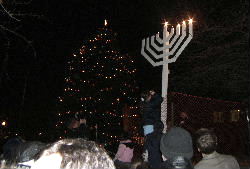
The town's holiday candelabra -- just lit last night for the first time -- stands close to the holiday tree.
Words and pictures by Sharon Bass
On the third night of Hanukkah, Rabbi Menachem Piekarski lit the town menorah. A small group of tiny kids to very senior citizens huddled before him on Dixwell Avenue as he sang Jewish prayers into the cold air. He then said, "Let's get warm!" And everyone dashed up the street to the Miller Library to party.
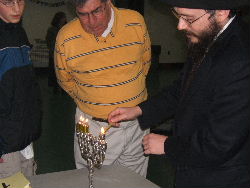
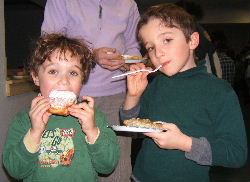
Rabbi Piekarski lights the menorah. Brothers Driebeek: Kyle, 5, and Julian, 7, of Hamden.
A room inside was decorated for the eight-day Jewish festival of lights. Three arts and crafts tables were set up for children. There was a table of latkes (potato pancakes), applesauce and doughnuts. Rabbi Piekarski lit another menorah and the room filled with melodic prayer as a bunch of energetic toddlers munched on huge doughnuts, promising to make them even more hyper.
Piekarski is with the international organization Chabad, which brings Judaism to Jews, such as last night's menorah lighting and Hanukkah party. Three years ago, the town joined with Chabad to put on the Hanukkah celebration.
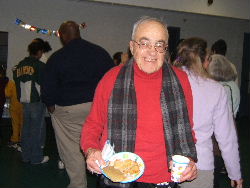
Hey, Sy Hatkin! Your applesauce is about to run off your plate.
The highlight of the party was Jewish "Jeopardy." Older kids and adults played. Squares of paper were taped to a wall, five across and four down. The top row of squares bore the name of a category: Miracles, Menorah, Etc., just like in the real game. Underneath were the numbers: 200, 300, 400, 500 and 600.
"I'll take Menorah for 200," called out Ira Caplan, a Republican who unsucessfully challenged Democrat Curt Leng for the 5th District Council seat this year.
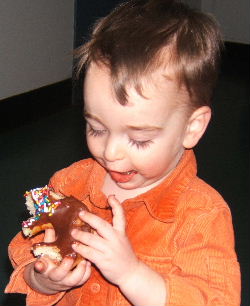
Levi Jaroslaw, 21 months, seems to be serenading his chocolaty doughnut. He lives with his parents, Joseph and Holly, on Washington Road.
Mayor Craig Henrici joined the outdoor lighting and stopped at the party for a spell. He ate one latke and said he is somewhat accustomed to Jewish holidays because his brother Ken Henrici (school super for Wallingford) married a Jewish woman.
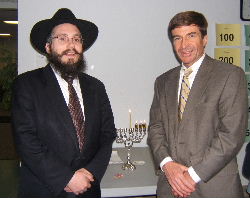
The rabbi and the mayor.
Asked to take another latke already, the mayor said he couldn't. "My son wants pizza, so I'm off."
December 22, 2005
Two Arrested, So Far, in Fatal Choking Case
By Sharon Bass
On June 11, a woman who was mentally retarded and in state custody was inappropriately left alone in a van in the Stop & Shop parking lot at 2335 Dixwell Ave, and began choking on a hamburger. Rosemary Hicock, 52, died the next day at the Hospital of St. Raphael.
Yesterday, Hamden police arrested Kimberly Rivnack, 40, of Waterbury, charging her with manslaughter and reckless endangerment with a bond of $125,000. The day before, Barbara Williams, 46, also of Waterbury, was arrested on the same charges and bond. Both women were state workers assigned to care for Hicock.
They allegedly left her alone in the vehicle for about an hour while they shopped, knowing there was food in the van, that Hicock ate way too fast and had choked on previous occasions, requiring constant supervision around food.
"There was an actual jurisdiction issue because it happened in Hamden," said Capt. Robert Maturo, explaining why Hamden is investigating. Hicock lived at the Southbury Training School and was in the custody of the state Department of Mental Retardation.
Hamden police have not concluded its investigation. "There were three people on the scene so there's a likelihood of a third arrest," said Maturo.
According to reports, the DMR has fired the three workers.
December 21, 2005
A Cook For All Eaters
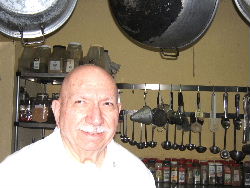
Veteran chef John Aftosmes runs St. Ann's Soup Kitchen.
Story and photos by Sharon Bass
At 7, he stood on a wooden soda box in front of the grill at his father's restaurant in Pennsylvania. He flipped patties and dogs. Sixty-four years later, John Aftosmes is still cooking for the masses but he no longer needs a box. He's a big man, in more than one way.
After a long career as a chef, Aftosmes hung up his apron only to be pulled out of retirement two years ago to run Hamden's only soup kitchen in the basement of St. Ann's Church at 930 Dixwell Ave. The affable man who seems at least 10 years his junior not only makes sure that poor people get a good meal Monday through Friday, he also makes sure that his guests at St. Ann's are treated with respect.
"It takes a lot of nerve to walk down those steps to come in here," he said during a recent interview at the soup kitchen. "So I try not to ask anybody questions that would put them on the spot." Such as where they live, where or if they work, why they come to the kitchen. It was founded in 1989 by St. Ann's former priest Father Bonadies.
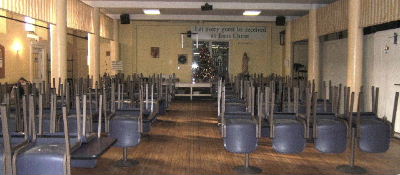
St. Ann's dining room, ready for Christmas dinner (in the far back is a holiday tree).
Aftosmes and the other two paid staffers -- Marshall Jackson and Pat Poole -- will serve a Christmas dinner this Friday from 11:30 a.m. to 1 p.m. They've put up a Christmas tree in the dining room of long blue tables and chairs. They've also got a battalion of volunteers who will help serve the holiday meal.
"It really was a big awakening for me to know there's such a large need for this operation," said Aftosmes. "You think, 'Why are they coming in here?' And you realize they can't get enough work."
Most of his guests work, he said. They're underemployed and underpaid. Men come in wearing tool belts and work boots. "These are people who have jobs, maybe work two to three days a week and earn minimum wage," said Aftosmes. And then there are the elderly, the children, the disabled, the homeless who frequent St. Ann's soup kitchen.
About 100 a day come for lunch. It's busiest at the end of the month when food stamps and money run out. Sixty percent are men; about 5 percent are elderly; 3 percent are homeless or have addiction problems.
John Carusone walked in during the interview. Not the former mayor but his cousin, who lives on Blue Hills Avenue. He was dropping off some non-edible donations. He said he'd be back the next day with Christmas dolls and stuffed animals.
"It's helping out a lot of people. I'm the kind of guy if someone says, 'I'm going to throw something in the dump,' I can find someone who needs it," said Carusone.
Donations are always in demand, said Aftosmes. He rattled off a list: nonperishable canned food -- "We have so much pasta and rice we try to discourage it" -- toothpaste, toothbrushes, shaving cream and razor blades, shampoo, soap. "Anything you'd have in your medicine cabinet in your bathroom," he said.
Volunteers are also needed to prep and serve meals. Most of the food is donated by area schools, said Aftosmes. "The schools in this area have been super to us," he said. He also gets victuals from the Connecticut Food Bank in East Haven every Wednesday morning.
And monetary contributions are always appreciated to help pay the utilities and salaries and to buy stuff Aftosmes can't get at the food bank, like aluminum foil, garbage bags, Clorox and ammonia.
St. Ann's kitchen is a far departure from what Aftosmes was used to. After leaving his native Pennsylvania, he was a chef at the Congressional Country Club in Bethesda, Md. Next job was assistant chef at the DeSoto Hotel in Arkansas. Then he moved to Connecticut to cook at the Ramada Inn in North Haven (he and his wife moved to Hamden in 1972). His second-to-last cooking job was with Servamation, a food service company that ran corporate and college cafeterias.
"After that I was told I was overqualified because I was 55," he said. "I was bitter."
So he switched fields and ran a small cleaning service. And then retired. Until his priest at St. John The Baptist Church on Dixwell Avenue in New Haven -- just two blocks from St. Ann's -- told him the Hamden soup kitchen needed a manager.
"I haven't regretted it at all," Aftosmes said. "First of all you're fulfilling a need. I'm 71 and I feel like I'm still productive. You wake up every morning and you know you're here."
Asked how much longer he'll toil at St. Ann's, the veteran chef said, "As long as I'm able, I'll be down here."
It's not for the cooking, he made clear. It's for the people. He's got five regulars who always sit at the first table by the door. Aftosmes calls them his board of directors. They talk politics and current events.
A couple of days ago a man and woman descended the dark steps to the soup kitchen to offer donations. Aftosmes said he recognized the woman but said nothing. "She said, 'Do you remember me?' I said, 'Yeah.' I remember her coming down here to eat and now she was here giving back.
"When you're in the workforce you're in your own little world," he said of his previous jobs. At St. Ann's, Aftosmes's world has greatly expanded.
December 19, 2005
Out of the Mouth of Radio Legend Bud Finch
Finch. Photo/J.R. Morton
The Hamden octogenarian talks about the evolution of the medium to which he dedicated his life
By J. R. Morton
Hamden's Bud Finch began his radio career in 1939 on WELI while a student at Yale. In 1996 -- when the corporate takeover of WELI occurred -- he retired from radio, having spent 60 years at that station, often developing innovative programming that remains a mainstay on contemporary radio.
However, he hasn't completely abandoned the medium. Every Saturday from 10 a.m.-11 a.m. on WQUN 1220 AM, you can catch him on "Once Upon A Bandstand."
Finch was born on New Haven's Dixwell Avenue in a house that no longer exists. He graduated from Yale in 1940, just in time to join the military. He was one of the first called when the Selective Service reactivated the draft, anticipating America's involvement in World War II.
I've been "interviewing" him for about four years. Usually we talk over lunch in his Mount Carmel home. What follows are his reminiscences of radio and his place in its history.
"We were called The Swing Shop. We had a trio and a singer, Dave Wrinn, who sang like Bing Crosby, who was very big at the time. I played piano. We had a very nice little show at 7 o'clock in the evening, one or two nights a week, which was on WELI, on the second floor, at 221 Orange St. in downtown New Haven. WELI is no longer located in New Haven. Where the studios were, there is a vacant lot and a small building where they have recording for the blind. That's where I do my volunteer work. It's interesting how the cycle goes. They say you can't go back, but you do.
"I had WELI on my mind when I was at Yale, and I had done a little radio but I wasn't really thinking about it seriously. One day, I was going down Orange Street and the WELI sign on the door caught my eye. I went upstairs and applied for a job. They didn't have any openings, but in talking with them and the fact that I had played there, I had some contact with the program director, who was Charlie Wright, and the station manager was Jim Milne.
"They were looking for someone to take the place of their regular organist Marion Reynolds, who was going on vacation. In those days everything was live. Every morning WELI had a program of live organ music from the Paramount Theatre. I told them that I could play the organ. As a matter of fact, I had played the organ only once in my life. Jim Milne and Charlie Wright said that they would have to hear me, so we made a date to get together in two weeks. In the meantime, I went over to the Paramount Theatre. Jim Darby was the manager of the Paramount. I asked him if I could practice on the Paramount organ. There was a great, big Wurlitzer with multiple keyboards that rose out of the orchestra pit on hydraulics.
"Eddie Weaver, who was very famous at the time, would play every show between the movies and the live performances on the stage. And there were sing-a-longs, when the audience would sing while the lyrics were projected onto the movie screen. The Wurlitzer organ was massive. It was all white and Eddie Weaver was dressed in a white suit. And when the spotlight was put on him, it was spectacular.
"Jim Darby let me practice on the organ in the morning for two weeks and I passed the audition. I played the organ Monday through Friday on WELI, for the two weeks that Marion Reynolds was on vacation. That endeared me to the management, so that shortly after that when they had an opening for an announcer, I got the job. That was the summer of 1939.
"In those days, when you were an announcer, you did everything. You might do news, you might do music shows or you might go on location. The term disc jockey hadn't been thought of. Records were played, but not very often. The legality of playing phonograph records over the air hadn't been established. Most radio stations were playing transcriptions, which were 16-inch plastic discs that revolved at 33 1/3 revolutions per minute. All other records were 78s.
"When I got out of Yale in 1940, I worked at WELI briefly. I also had a band that played at the Hotel Taft in New Haven, which was the most elegant spot in town. We played in the Colonnade Room, which was a basement nightclub. We had a good band and we were very well received with capacity crowds. Between working at the radio station and the band, everything was going very well. When my number came up and I was drafted into the service, I tried to get into a branch of the service that would be exciting. It was in 1941, and I was working the Sunday afternoon shift. A man came in and said he had a public service announcement he wanted us to broadcast. We used to do a lot of community announcements without giving the content much thought. The usual notices about an organization having a meeting or a supper, or a church is having a musical event. Radio has done those over the years.
"The man wanted me to put his announcement over the air right away, and he left. I read the thing over a couple of times and I was a little suspicious. There was something about it that struck me as being not just right, but I couldn't figure out what it was. I couldn't reach anyone from management, so I called the police. The police said they would have someone call me back, and it turned out to be the FBI. They came up and wanted to look at the announcement, and they said that I had done the right thing by not putting the announcement on the air because it was part of a German spy ring that was trying to sabotage the largest defense plant in the New Haven area, Winchester-Western, which was supplying guns and ammunition to our allies prior to the United States' involvement in the second world war.
"The FBI believed that the announcement was, in reality, a coded message that was intended to reach German infiltrators. The agents said that I had done a great service, and then they asked if I would like to talk to them about working for them. They gave me an address on Church Street. The following week I went to that address. It turned out to be an office with a blind door, and when I got inside it was the local office of the Counter-Intelligence Corp., very well disguised.
"Several agents and I spoke for a while and they asked if I'd like to go to Boston, to the regional office. So I went to Boston and I signed numerous waivers, essentially discharging the government from all responsibility. If my parents had known what I was doing, they would have killed me. But I didn't tell anyone. I wasn't supposed to. I completed the exam, then my number came up and I went off to Camp Devens where I waited to hear from counterintelligence. When I did hear from them, it was a rather cryptic message turning me down. They were looking for someone who spoke Italian. No one knew at the time that the plan was to go into Anzio and complete the invasion of Italy. The agents wanted someone who could go behind the lines and could speak the language like a native. If I had gone I would have probably gotten killed as half of the spies did.
"Instead of being a spy behind enemy lines, I ended up in the ground forces in the meteorological section and doing reconnaissance, flying small planes, reporting artillery fire, which was something I didn't enjoy. The planes were unarmed, little one-engine Piper Cubs, flying a thousand feet above the guns. Very, very exposed.
"I wanted to be transferred into the Air Force because Glenn Miller, a very popular band leader, had taken over the Air Force music program. Miller had his organization set up so that he had a front line orchestra and a backup orchestra. The front line organization was made up of all the musicians he could grab from his highly successful civilian orchestra. That was in 1942, and Glenn Miller and his group were stationed at Yale University. The orchestra often played on the New Haven Green and people still talk about the great concerts.
"When I came to see Glenn Miller, he was living in the Taft Hotel, but the rest of the band was living in the Yale dormitories. Glenn Miller was supposed to have his headquarters in North Carolina. When I first was transferred to North Carolina, my orders stated that I was to work with Glenn Miller, but he never showed up. Miller stayed with his main band in New Haven, and his second band was stationed in North Carolina. The plan was that Miller was going to Europe with his main band and our band would go to the Pacific to entertain the troops. That's the unit I was with. In fact, we spent all our time planning for that transfer. Our orders came that we were going to the Philippines in August of 1945.
"I was all set to leave when the crew of the Enola Gay dropped the first atomic bomb on Hiroshima. That changed the war and all our plans. We ended up at the Air Force base in Greensboro, N.C., until the end of the war. It worked out very nicely for me. I did a lot of radio programs and played a lot of music. With all the contacts I had made, I thought I would go into music once the war was over, but I came back to Connecticut. My parents were here and were getting older, and I was concerned about them. Also, I got married and I didn't want to travel. Band business meant being on the road all the time. This was in 1945 and '46. I decided to go back to the radio station. They had to take me back because I had been working for them when I was drafted. Once your term of service was over, your employer had to rehire you at no less a job than the one you had when you were drafted and keep you for at least a year. That was the law.
"WELI didn't want to take me back because there had been a change in management and ownership. I wrote a letter saying I was coming back, and, in essence, management said, 'Don't bother.' I went down to the studio on Orange Street and told them that I thought I could be helpful to them. After all, during the war I had done a lot of radio work, going coast to coast and around the world. I had been on Mutual and then CBS on a program called 'On The Beam.' It was an Air Force show and I had been musical arranger and announcer. I worked with Lon Chaney, Tyrone Power and a host of people who were great contacts. I told the management team that if they didn't want me at the end of six months, I would leave voluntarily. I knew that there was another station starting up across town, WNHC, and it was made up of people who had worked at WELI prior to the ownership changes. After three months, I was given a raise with increased responsibilities.
"When I came back to WELI they wanted me to write copy, produce some commercials and do staff announcing. There was much live programming and very little recording. And don't forget, recorded tape wasn't in existence. If you wanted to do a program ahead of time, you had to transcribe it on a 16-inch disc. The discs were aluminum with an acetate coating. The recording process was a very cumbersome one, almost a Rube Goldberg-type of process. The prerecording was done only in extreme urgencies. Management didn't like to go to prerecorded programming because the fidelity wasn't up to usual live broadcast standards. And with those discs, anything could happen, and often did.
"One time my dear friend Bill Hanrahan was at WELI. He worked the Sunday morning show. We used to have religious programming on Sunday mornings, as most stations did. The shows were all on transcription, on 16-inch discs. Bill was a very devout Catholic and he had to go to mass on Sunday morning. Bill worked out a deal. We had an hour show, which was two sides of a 16-inch disc, playing at 331/3 rpm. If he started the disc at 8 o'clock and he could get the engineer to turn the disc over after a half-hour, Bill would get to St. Mary's Church for mass, which was only a few blocks from the radio station, and come back in plenty of time before the disc ended.
"This particular Sunday morning, Bill set the disc in motion and headed over to St. Mary's. The engineer who assured Bill Hanrahan that he would turn the disc over at the proper time was inclined to celebrate sometimes on Saturday nights. The engineer was a little hung over and he had dozed off. Unfortunately, the disc got stuck. And it got stuck just as the reverend was giving this real exhortative-type speech where he was saying, 'And so will God damn the angry sinner,' but the needle got stuck at, 'God damn, God damn, God damn,' over and over again. Of course in those days, any swearing was prohibited. You couldn't say hell, you couldn't say damn, so this was awful. The station manager was home listening, Bill Hanrahan was blocks away in church and the engineer was passed out in the studio. The station manager called up the station and wanted to know what was going on. He woke the engineer and wanted to know where Bill was. The engineer said, 'Well, sir, I don't know. I'll look for him.' He was just trying to make excuses without getting Bill in trouble.
"When Bill got back from mass, he learned what had happened. He was sweating bullets. The next morning when Bill came into work, he thought he was going to get fired. But he told the station manager that he was a loyal Catholic and he absolutely had to go to mass, and the station manager gave him a second chance. Later, Bill Hanrahan went on to success at NBC. Things like that happened all the time in those primitive days of radio.
"Radio was fun in those days. So much of it was live. There was a performance ethic in those days, which you don't have today. You had to be right, so you had to prepare yourself. If you weren't sure of something, you had to check it out ahead of time and rehearse, as well. Everything was done in one take. Everything had to be done right. It was much more of a challenge for a performer and they had a higher degree of skill or perfection in those days, out of necessity.
"That was the process we used in the late '30s and early '40s. When we came out of the second world war in 1945, wire recording existed, but it wasn't very clear or reliable. We had stolen the idea using ionized tape from the Germans, and so magnetic recording tape began to appear a year or two later. By 1947, we were using tape on 7-inch reels to record programs, and that transformed broadcasting. More prerecorded shows came into being, and you could edit. We no longer had to haul those large 16-inch transcription discs around. They were history.
"Early on, most of the shows were 15 minutes. No show was ever longer than a half-hour. It wasn't until we started having morning shows, which I started in 1947, that we had longer shows, say three or four hours. At WELI, we had two studios. Just two. We would have a band in one of the studios playing a live 15-minute show, and there would be a singer in the other studio rehearsing to do the next show. At the same time, a band that would come on after the vocalist would be rehearsing in an office down the hall, or even in the men's room. Everything was going on all at the time on the second floor at 221 Orange St. In every conceivable space, someone was getting ready to go on the air. It was a lively, exciting time to be working in radio.
"In the early days at WELI, the morning schedule tended to be mostly Italian programming because New Haven had a large Italian population. There were Italian announcers speaking Italian sponsored by Paramount Macaroni and other Italian products. Sunday evening we had a Hungarian hour, and we had Hebrew hour. On Sunday mornings we'd have an hour of Polish music.
"The foreign language programming was in the pre-1942 era. When 1942 came along and we were at war with Germany, Italy and Japan, the government didn't want any foreign language programming aired because of the fear of messages and propaganda being inculcated, and the FCC couldn't monitor every station and every broadcast. The foreign language program hosts, headed by Aldo Bonnevini, found an AM frequency available in 1943. That became WNHC, which later became New Haven's first television station, Channel 6, which is now WTNH Channel 8. When I came back from the war, radio had changed significantly. The shows were all English, and more of our programming came from the networks.
"By the late 1940s some of the morning programming was from the network. Then there was local news from noon until 1. Then the networks took over in the afternoon with soap operas and quiz shows. But that didn't last very long. By the early- to mid-1950s our programming became local again as fewer network shows were being produced. There were some nighttime network shows such as 'Yours Truly, Johnny Dollar,' and they lasted into the early 1960s.
"In 1954, I started doing the morning show, actually by mistake. Ben Hawthorne used to be on in Hartford, and he was carried in New Haven, as well. His show was called the 'G. Fox Morning Watch.' In 1943, he went into the service and was replaced by Bob Steele. For some reason WELI didn't carry Bob Steele in New Haven. WELI decided to go local with Jack Ryan and Clyde Dill in the early morning. This was in the winter of 1946-47. Jack Ryan was notoriously late much of the time, and you couldn't be late for a radio show. I was announcing in those days, so the station manager would have me cover for Jack Ryan. And that was with no preparation. Eventually, the station manager's patience wore out and Jack Ryan was fired. They put me in his slot, from 8 to 8:15. The show became sponsored by the W.T. Grant Company. Grants was a five-and-10-cent store in downtown New Haven, along with Kresge's, Woolworth's and A.J. Newberry's. The show grew to a half-hour. Whatever I was doing was successful and my segment kept growing. Eventually my show ran from 5:30 until 9 in the morning, followed by the ABC network Don McNeil 'Breakfast Club' show, from the Sherman Hotel, in downtown Chicago. Later on, my show ran from 6 a.m. until 9:30.
"I did the morning show from 1947 until 1972. Twenty-five years. In the meantime, morning radio became the hot time of day because television began co-opting the rest of the day. If you were doing morning radio, you became famous. All kinds of good things began to happen.
"I had a very smart boss. He said, 'Look, you have to please the people. It's the people who determine what music you play, not you. You're a guest in their home and you have to behave like a guest.' That was his concept and I think it was a good one. That's not the trend today at all. Today it's all shock radio. You're not a guest. You're an intruder. Because it's become so competitive today and there are so many people going shock radio, the one who gets the attention is the one who shocks the most. It's a different profession today.
"In the late 1940s I had my competition as well. I was up against 'Bob & Ray' on various stations, Arthur Godfrey on CBS, Bob Steele was on WTIC, Bob Crane on WICC -- who later starred in 'Hogan's Heroes' -- Steve Allen and Dave Garroway, who was the first emcee of NBC's 'Today Show,' and later Jack Sterling. I was successful to the point that I received job offers from radio stations in Washington, D.C., and New York City to do morning shows, but my wife and I had our first child, and I was never one to be overly ambitious. Those offers were huge opportunities, but I was satisfied with the balance of working on a great radio station with some independence and not having to move my family. I stayed in New Haven and I'm not sorry. A number of people made the New York scene and wound up in trouble. It was such a tough market. A lot of problems and pressures.
"I was the first person to ever broadcast from a train, a submarine, a blimp and an airplane. The train broadcast occurred around 1955. Jayne Mansfield was premiering a movie in Rhode Island. Her publicity people were running a special car for her and had it set up the interview . I got on the train and went into her private car. Jayne Mansfield took me into her bedroom and said that we're doing the interview sitting on her bed, traveling from New Haven to New London, live on radio.
"In 1956, there was a blimp on the New Haven Green and someone suggested that I broadcast from the blimp. I had never been on a blimp before. It was a very funny feeling because you go straight up in the air and we did the broadcast while floating over New Haven and the harbor.
"In 1962, I created a program called 'Beautiful Music Radio,' and the Navy had just begun producing atomic-powered submarines in New London, Conn. I don't know who got us involved with it, but someone loved 'Beautiful Music Radio' and they wanted us to program tapes that could be played on the submarine when they went on long cruises under the North Pole. When the subs were underwater for months at a time, they were out of contact with commercial radio, so we started furnishing the atomic subs with our programs. Months and months of tapes at a time. And when they returned to port, we had a new supply ready for them.
"One day, the submarine base had a special VIP event where they wanted to publicize the success of their submarine program. I was invited on board the Abraham Lincoln, along with several politicians, to go to New London and cruise Long Island Sound underwater. When we surfaced, I sat on the bridge with the captain and asked him how fast were we going. He said he couldn't tell me because that was classified information but that we were doing better than 20 knots.
"Then came the broadcast from the airplane. Eastern Airlines announced they were going to start providing air service to New Haven by flying into Tweed Airport. This was in the winter of 1956. Someone from WELI suggested that I broadcast from an airplane. The station was going to provide me with an engineer and a short wave link. Eddie Rickenbacher, the World War I flying ace, was president of Eastern Airlines, and he was going to take the first flight from New York to New Haven to inaugurate air service between the two cities. There was a major reception planned with a band and a number of politicians and business leaders scheduled for Tweed Airport. It was going to be a big deal.
"I said I'd broadcast from the plane. Steve Tabor, my engineer on the morning show, went down to New York with me. We loaded his station wagon with all the radio equipment we would need. We were supposed to leave Laguardia at 8 in the morning, and fly into New Haven around nine for the reception. That meant we had to leave New Haven by 6 in the morning because in those days we were traveling on the old Route 1. As you would expect, there was an ice storm. I woke up in the morning and I called Steve. I asked him, 'Are we going to go?' Steve said, 'Well, we have to. All the plans have been made and we're going to fly in with Eddie Rickenbacker.' Steve came by and picked me up around 5:30. We drove about 10 miles an hour to New York. The road is a sheet of ice all the way and we were both scared to death.
"Finally, we made it to Laguardia and we drove out to the field. We met the crew and we started setting up for the broadcast, but conditions were terrible at the airport. I found out that Eastern is the only airline that relies on the flight captain to determine whether the plane should fly or not. It doesn't depend on management or air traffic controllers to make the decision. We were talking about whether we should fly, and the captain didn't see a problem. The plane was a DC3, a big, prop workhorse during World War II. We loaded the equipment on the plane. With all the ice, I wasn't worried about getting up in the air, but I was worried about skidding across a runway when we touched down.
"As we got ready for takeoff, I asked, 'Where's Rickenbacker?' The pilot said, 'Oh, he called up. He's going to New Haven by train.' I turned to Steve Taber and said, 'He's going by train and we're flying. What's the matter? We crazy?' It happened to be Steve's first flight. We did the live show, the descriptions, but there was no World War I flying ace. Eddie Rickenbacker was picked up at the Union Station and driven to Tweed Airport for the ceremonies. I never got to do the interview with Captain Rickenbacker because by the time he got to the airport he was mobbed by the mayor and members of the chamber of commerce.
"Management always wanted to expand when something was successful. The morning show was called 'The Coffee Club,' so we started 'The Bud Finch Show' from 1 until 2:30 in the afternoon. My boss, Dick Davis, a wonderful man, was general manager and a very bright and farsighted guy. He said, 'Live music used to be great.' The last live band on radio in Connecticut was Norman Cleaudea, who had a live orchestra on WTIC in Hartford. He used to broadcast from noon until 1 on weekdays until just after the war, around 1946 or '47. The station couldn't sustain the cost of paying a full orchestra of 15 or 20 musicians.
"I continued doing live music on my morning show. I had a piano, an organ and a Celeste in addition to records. I called the piano Sammy Steinway. Dick Davis said, 'Why don't we have a live show in the afternoon with a small group of musicians that wouldn't cost too much.' I got a guitar player and a bass player to go along with my keyboard playing. Charlie Wright was program director at the station and he could play the drums with brushes. Allen Delay had a disc show in the afternoon who was a singer, and we had a woman working in the office named Susan Bardo, who was a fine vocalist. We got together and every afternoon we had a live show. The show was so successful, that we took it on the road. We'd play at local clubs and civic organizations, and we really built up our audience.
"Dick Davis believed that one of the responsibilities of a radio station was to build up good public relations. WELI was probably the first station with a segment devoted to women. It was called 'A Woman's Point of View' and that was started by Jean Slayton, probably in 1939 or 1940, and it carried on into the 1960s with Jean Porter and later by Jean Loucks. We kept the afternoon music show going until late 1957. We did gags and dramatized spots along with our music, and we were the last radio station in New England to perform live music.
"I had a pretty tough working schedule. I'd start broadcasting at 6 in the morning, and finish at 9:30. Then I'd start writing and rehearsing for the afternoon show. We had to rehearse because it was live, all one take, so it had to be right. I was happy, in a sense, when we had to give the show up.
"As I've mentioned, Dick Davis was a farsighted individual. In the 1960s virtually every station was playing rock 'n' roll. Dick had a consultant who was promoting the concept called 'The Theater of Beautiful Music.' His idea was that there was room in every marketplace for a station to play a wide variety of good music. We decided that with every other station in the state playing rock 'n' roll, we would do something else. That's when I started and coined the phrase, 'Beautiful Music Radio.' During the night we played a mixture of semi-classical music, and during the day we played popular music, but no rock. That worked out very well, and we carved our place in the radio market because we were the only station doing that. After a few years, other stations copied us. I brought in a man named Nick Papp as music director, who as a musician had played trumpet in my band. I knew I could trust him. He had good taste and he knew what we were talking about.
"In the 1950s and early 1960s, the record companies would send their releases for free. In fact, the record distributors came around to the radio stations to wine and dine us so we would play their records. They couldn't do enough for us if you gave their records airplay. They'd give us theater tickets, pay for trips to New York. In lots of cases in bigger markets, they were paying deejays, getting them dope and women and things like that. I didn't get involved in anything like that but I did take two of my daughters to New York, saw some plays and went to recording sessions that the representatives had set up. They did that all the time. By the late 1950s during the payola scandals, people were taking gifts and money under the table, but I never got involved with anything like that.
"Al Ham, who came up with the concept of 'The Music of Your Life,' which is very popular now, lived in West Haven within earshot of WELI. He was a bass player who played with my band when we played at the Hotel Taft. He had a real gift. I taught him how to arrange, and after the war he worked with Mitch Miller at Columbia Records as an A&R man. He got the idea for 'The Music of Your Life' from listening to 'Beautiful Music Radio.' In fact, he tried to get me to go to work for him. He began to produce 'The Music Of Your Life' in his garage, then he syndicated the concept, rotating the tapes. His organization sends the tapes to radio stations every month and the stations have an automatic program. They don't have to hire people.
"By 1962, my 'Beautiful Music Radio' show had been running six years, and I was concerned about the number of stations that were copying us. I began to think about another format. We had done request shows where people would call in and tell us which songs they would like to hear. Based on that, I developed a show called 'RSVP.'
"It was to be a talk show where we would have an expert in a particular field or a famous person on as a guest and invite listeners to call in and ask questions. That seems like a very common format now, but when I conceived the idea, there was nothing like it on the air. 'RSVP' came on the air the same week that John F. Kennedy was assassinated, late November of 1963. One of the first 'RSVP' segments we did was a roundtable discussion on Kennedy and his presidency. That show lasted for quite a few years, before everyone began to go into talk radio.
"I stayed on the air until 1972, when WELI was sold. I was offered the post of assistant general manager, but I didn't want to do that job. I did stay on the air doing editorials and point of view. Over the years, WELI was sold and resold, but I stayed on.
"After WELI was sold to Clear Channel Communications I left, in 1996. They own 1,200 radio stations. When they took over WELI, they took out the entire music library and made the area into offices. They threw out all the music, all that history. It was a big corporation with little consideration for individuals, so that's why I stopped. Because now, radio is a whole different ballgame.
"Corporations buy stations to sell them. Put stations together and make deals like car dealers. There is no personal interest, and no real commitment to the communities in which they broadcast. There are very few independent radio stations left.
"There was a philosophy I remember. We were taught that when a radio station applied for its license from the Federal Communications Commission it had to guarantee that that station would 'operate in the public interest.' Today, there is no public interest. A radio station had to provide so many hours per week of religious, agriculture, education and a number of other subjects beneficial to the community that the station served. When a radio station filed its renewal application, the station had to go through a thorough process to prove that it was providing services and operating in the public interest. The FCC could come in at any time and inspect the radio station, review the station's logs, or monitor you and take away your license.
"Today, a radio station renews its license to broadcast by postcard. It's automatic today. There is no accountability. The only way a station could lose its license today is if someone used one or more of the seven forbidden words on the air. And I hear some of those on the air. Public taste is so low today, it doesn't matter. Shows such as 'Entertainment Tonight' pass as journalism.
"At the end of World War II there were around 2,000 radio stations, with most of them focusing on local programming. Now there are more than 11,000 radio stations in the country, and except for a precious few, the vast majority of stations play the same music and recite the same news. Outside of public radio, there are precious few exploratory or serious efforts to serve the public. That's about it. I could see how much radio had changed and that it was never going to return to local programming, back to its commitment to public service. And that's when I retired.
"Once I got into a discussion with Les Brown, the radio and television historian and critic. He said he believed that I had the national record for length of service with one radio station, nearly 60 years. I cared about the station and about the quality of the programming we gave to the community. I developed numerous formats that are still with us, and I pretty much gave my life to radio. When I left, I knew that I had given it everything I could."
J.R. Morton is a pen name.
December 14, 2005
Story and photos by Sharon Bass
Nothing -- I mean nothing -- was off limits last night at Jack Kennelly's, uh, roast, or toast or whatever the hell the excuse was to throw the new police chief a big party. The place was the Laurel View Country Club and it was packed with cops, politicians, Town Hall workers, lawyers and more cops. The jokes were crude (lots of little boy potty humor). The evening was a total gas.
After guests juiced up at the bar and feasted on calamari, pasta and roast beef at the trough, the toast began. Perennial MC Mike Iezzi (aka Hamden Republican Town Committee chair) ran the show. All toasters were male cops, of course, who uproariously showed they had the balls to hit below Kennelly's and each other's belts.
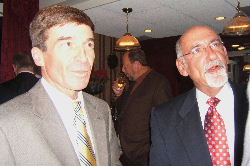
Mayor Craig Henrici and Police Commissioner Marty Ruff.
First up was Police Chief John Comparetto of Wayne, N.J. "For the young guys, you can't get away with anything. We've done everything," he said of his and Kennelly's drinking and partying in the '80s. He told a tale of passing Kennelly's business card to the "smelliest female urchin" at a bar one night, when Kennelly was a sergeant. He told the woman he was the "big shot" Kennelly and to give him a call. Apparently she did. Or so Comparetto said, which triggered back-and-forth phone calls between him and Sgt. Kennelly.
Former Mayor Carl Amento said upfront that he couldn't compete with the likes of Comparetto. Amento appointed Kennelly chief this fall. "To me there was no other choice. He's the best. He's a killer of a guy," he said.
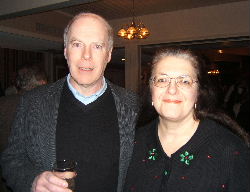
Town Clerk Vera Morrison with hubby, John.
Back to the bashing.
"People ask very often how do you become a chief," said East Haven Police Chief Lenny Gallo. "In Jack's case he was caller No. 8." After a string of pretty funny jabs, his voice softened. "Jack Kennelly, you're truly going to be a wonderful chief. God bless you."
Then Bobby LaTorraco, CEO of American Medical Response (AMR), took a whack at the mic.
He said he moved back to Hamden last Thursday. "It dawned on me that the Hamden police are so dedicated (that they never leave and) as they get to the end of their careers, they get senile," said LaTorraco. Former Police Chief Jack Ambrogio "left in an ambulance," he said. Bob Nolan, whom Kennelly replaced, "I bring him a wheelchair and a Star Wars lunchbox."
He called Kennelly "Joe Camel," because the chief is a big smoker. "A balanced diet to Jack is a Camel in either hand," said LaTorraco. "Jack, you're a class person. You're a good friend. You're a good husband."
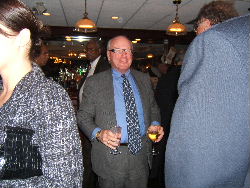
Here comes Sen. Joe Crisco with both hands loaded.
Nolan followed.
"I was going to be really nice tonight but Ambrogio told me, 'You don't have to be politically correct anymore,'" because Nolan is now retired.
He made fun of LaTorraco's height, suggesting he stop walking on his knees. Cracked a few more jokes, and then turned to his successor. "All joking aside, I wish Jack the best. He's put in 30 years on the force."
Things really heated up when Ambrogio had the floor.
"This is the first semi-annual Jack Kennelly appreciation dinner," he said, eliciting a huge laugh from the audience.
"Jack has taken all the politics out of the chief's job," Ambrogio said. He pointed out that Kennelly had been a town councilman, chair of the Council's Public Safety Committee, a former Republican and today a Democrat.
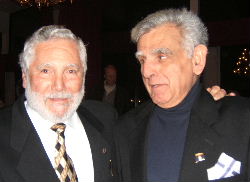
Pals Jack Ambrogio and John Carusone.
He made humorous remarks about some of his past nemeses, such as former Mayors John Carusone and Lillian Clayman. "Ann Altman writes, 'It was best when we were enemies. My site was so busy,'" he said of the former councilwoman who runs the Web site, Hamden Women for Honest Government.
Iezzi took a different tone. "As I look around it really warms my heart. Both parties. People who have fought for years," he said. "Jack's a good cop. He's a good friend. And everyone knows his favorite saying, 'I don't get mad. I get even.'"
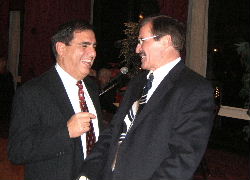
Mike Iezzi and the chief.
Then it was the man of the hour's turn. He got even.
About Ambrogio, Kennelly said: "Can you imagine the nerve of him saying I have a semi-annual function? He had 153 of them a year and is still waiting for another."
About LaTorraco: "He's a character, isn't he?" And then referred to him as an "asshole." He called AMR, American Midget Recovery.
With Kennelly's wide trademark grin, he said to the AMR exec, "You thought it was going to be fun. You thought you were going to get even with me.
"If (LaTorraco) could ever find anyone to love him as much as he loves himself, it would be the love affair of the century. He has to have two offices -- one for himself and one for his head."
Kennelly launched into stories about LaTorraco's chronic flatulence. You had to be there and you have to be a guy to really appreciate the jokes about having gas and having to release it in socially unacceptable places.
Moving on.
"Ambrogio, you're next.
"He's the only police chief who got paid 22 times for his vacation pay.
"Look at the guy. He's about 103 years old and he'll outlive all of us.
"He has an ego only second to John Carusone.
"Now, Jack, you know I love you."
"I'd like to take a moment to say something about Mayor Craig Henrici," said Kennelly. Henrici had already left the party.
"He left a law practice where he was making $150,000 a year to become mayor. When asked why he said, 'I really want to give back to the community that has been so good to me.' Yeah, right. And I have a bridge in Brooklyn to sell you."
Kennelly continued. "I will never forget the faith and confidence Carl Amento has for me." And he then spoke warmly of the two women in his life: his sister Mary Ellen Kennelly and wife, Pam.
"I promise to be the best chief of this town."
December 13, 2005
Eva and Her Boobs
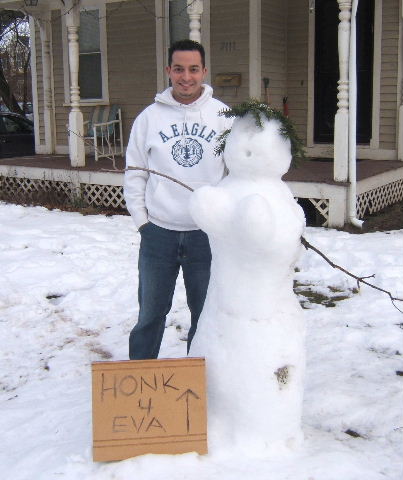
Eva with co-creator/admirer Mark Milano. Photo/Sharon Bass
Three QU students build the woman of their dreams
By Sharon Bass
If you've driven by 2111 Whitney Avenue since the snowstorm, you've probably seen Eva. She's a shapely woman that stands outside all day and night sporting the sign, "Honk 4 Eva."
She's made of what fell from the sky last Friday. Her creators are three Quinnipiac University seniors -- all guys, natch. They say they've taken a real liking to her and seem pretty possessive of the snowchick they named after actress Eva Longoria, of TV's "Desperate Housewives."
"We wanted to build a snowman but we're college guys and I've never seen a snowwoman," said Mark Milano. He and his roommates Gary Ragusin and Chris Goodall did the handiwork, which took them one and a half to two hours. They used kitchen knives to sculpt Eva's curves "so you can tell it's a woman," said Milano.
"We've had quite a bit of honking," he said.
"It's not every day that you see a female snowman," said Ragusin. "We wanted to spice it up a bit. To wake up to honking for Eva isn't so bad."
But honking is about all these guys will tolerate when it comes to their Eva. "I think we need to be the only guys around her," said Milano.
He said there was no "real driving force" behind the idea to make their woman. "We just wanted to have fun" in the new snow, said Milano. "I've had the occasional snowball fight and built small snowmen, but nothing of this caliber."
The three Eva creators live with two other Quinnipiac seniors in a privately owned house. They've known each other since their freshman days and lived on campus until this year, only moving to Whitney Avenue because the school doesn't provide on-campus housing for seniors. Their home is clean and tidy. A "no smoking" sign hangs on the front door.
"It's more convenient living on campus," said Ragusin. Milano agreed, saying he misses being around the other students and getting cooked meals.
But what about Eva? Could they have made her on campus?
With more snow predicted this Thursday, the guys plan to build another Eva. Asked what she'll look like, Ragusin said, "We'll use our imagination. The more the merrier."
December 10, 2005
Words and photos by Sharon Bass
After weeks of various town-wide efforts to collect toys and clothing for needy kids, yesterday parents and grandparents came out in droves -- waiting up to six hours on line inside the Keefe Center -- to take the gifts home for the holidays.
Pickup time started at 10 a.m. but people started lining up at 6:45 a.m., said Vanna Francia, director of Community Services, the town department that orchestrated the toy drive.
"The fact that people are here that early, it just shows you what they do for their children," she said late in the afternoon from the overly heated Keefe gym where the booty was kept. "There's nothing for adults here."
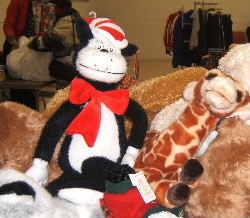
Poor Cat in the Hat and friends. No one seemed to want them.
Three adults at a time were permitted in the gym to take a maximum of three items per child. Francia said there were 1,500 toys and articles of clothing for the 461 kids on the gift list. The hottest item was a new dirt bike, which naturally was snatched up at the get-go.
Community Services got a lot of help in collecting gifts and money. The Hamden High cheerleaders, local unions, both political town committees, the Hamden Police Benevolent Association, American Dance Experience, Laidlaw Bus Company and the Bank of America pitched in.
Gretchen Ferri went shopping with the nearly $3,000 that was raised. She found stuff at Kohl's, Toys R Us, Walgreens and the Gap. She said she was particularly impressed with the Gap.
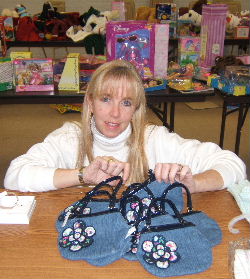
Gretchen Ferri couldn't say enough about the Gap's generosity. She said she bought these little denim purses there for a song.
"Gap was unbelievable," said Ferri who works for Community Services. "Gap did so much for us. I couldn't believe it. I was crying in the store." She said the national chain store gave her "huge, huge" discounts on polo shirts, jean jackets, "a ton of girl's pocketbooks" and baby clothing.
Also, Party City donated countless rolls of wrapping paper.
December 8, 2005
Local inventor makes garbage a little friendlier
Story and photos by Sharon Bass
Bob Roscow has two burning objectives in his life right now: to market his trashcan straps and to sue the state of Florida. They're not related issues, but they're both as real and kicking as the Woodlawn Street man himself, who is also the town's Zoning Commission chair.
First the straps.
"Unlike other invention ideas I've had, I can tell you exactly when I thought of this one," Roscow said from his very cluttered home, where boxes and books and papers and all kinds of knickknacks occupy every inch of living space.
The idea came to him about five years ago while staying at a Florida motel (no connection to the lawsuit), said the 56-year-old architect-turned-inventor. About every two months, he'd fly down there to visit his ailing mother in the small town of Inverness, where Roscow grew up.
Being a small town and all, there is just one motel which has "teeny, tiny trashcans," he said. As is often done, the plastic garbage bag inside the teeny, tiny can was knotted on the side to keep it from sliding off.
Yeah, right. The knot didn't work, as Roscow learned when he disposed fast-food wrappers in the trash receptacle. Here's what happened.
The restaurants in small Inverness close at 8 p.m., which posed a dilemma for the budding inventor who is used to eating a late dinner. So it was either the golden arches or the king for nighttime eats.
He brought his takeout meal to his little room in the little motel in the little town. When he threw the wrappings and Styrofoam (still used at the turn of the 21st century) the plastic bag -- knot and all -- took a nosedive into the teeny, tiny trashcan.
Later for that, he thought. Once back in Hamden he went to Jo-Ann Fabrics on Dixwell Avenue to buy elastic straps, Velcro and glue. His brain matter was in high gear. He was cooking. He had an idea.
The garbage-bag problem was not unique to the itsy-bitsy trashcan in Florida. He had experienced it often in his life. And, he learned, so have others.
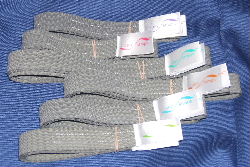
Roscow's straps.
Roscow got busy. He cut the Velcro into 4-inch strips and glued them on either end of the elastic bands. He then wrapped a strap around the rim of his kitchen garbage to hold the plastic bag in place. He said nothing about it to his wife, Beth, a special ed professor at Southern Connecticut State University. The two used the kitchen garbage all week without a word about the new can strap.
At the close of the week, he and his wife finally discussed the strap. Both conceded to pushing and pushing the garbage down all week while the bag stubbornly clung on.
Roscow called a patent attorney in Stamford to see if his can-strap idea was already taken. The lawyer's search revealed nada.
Things were going swimmingly. Roscow could smell his can-strap fame approaching, when he discovered the attorney never sent his application for an "adjustable liner retainer" to the United States Patent and Trademark Office. The lawyer forgot.
So it was later for the Stamford lawyer, and Roscow retained new counsel in Hartford, who finished the job.
"The fees are astronomical," said Roscow. When asked how much he's spent so far on his invention, he said, "Well in excess of a small house in Hamden." While the bounty of the money has gone to legal bills he's had other invention-related expenses, and not one strap yet sold. He figured he'd have to sell 100 million to 300 million a year to recoup his money and then some.
Roscow designed the straps himself but hired Cheney & Company in New Haven to do the logo and marketing. He's also paying for strap production, which is being done in Asheboro, N.C.
Originally, Roscow had seven sizes in mind. That was scaled down to four, which measure 22 inches to over 80 inches, he said. Each strap has a label that is color coded according to size. For instance, purple is the smallest. A twin set is expected to cost $4.99, with the inventor getting a "really small" royalty.
He said he's negotiating with a national hardware chain to carry his straps, but didn't want to reveal the company's identity just yet. Roscow is also peddling his invention to stores, a health-care facility and a bank, all in Hamden.
"I like to compare it to a Band-Aid," he said. It's a simple invention "but has a lot of utility. Let's put it this way, there are billions of garbage cans in the world and people are frustrated with bags slipping in."
Roscow said his straps are currently being tested at the Cotton Gin on Whitney Avenue, a doctor's office in Cheshire and the Holiday Inn Express in Asheboro. Plus, he's given can straps to friends who reported they didn't know how they ever did garbage pre-strap days.
"Anybody who's ever had them swears by them," he said.
Positive feedback is what he attributed to his stick-to-itiveness. Especially since it's taken five years already and he's hit a few walls. "Friends who have used it and these test sites just can't believe how easy it is and how it takes care of the problem," said Roscow. "These are washable. They're reusable. The only criticism I've gotten is they don't wear out." Meaning, he won't get much repeat business.
However, there is a silver lining. The straps, the Zoning chair said, can accidentally fall into the garbage bag when being removed and thrown away.
But what about big rubber bands and bungee cords? Won't they do the trick?
"People use them. They work but they're not real safe," said Roscow. They can snap in your face when removing them.
The former architect has worked on other inventions, but none have gone as far as the straps. Beforehand he had gotten a patent for a "micro-tuss," which is an "ultra strong material made of wire to be used on structural panels, like walls," he said. Roscow also got a patent on a super-duper TV remote control idea, which has computer ability to update the remote according to TV Guide listings. Both ideas are on hold.
Some of his inventions never made it to the patent office. Like the one he dreamed up for a remote-controlled military helicopter with multiple warheads. His latest brainstorm is a driver monitor.
"Some people would call it Big Brother," said Roscow. The device is designed to make a sound or movement to alert someone who's driving unsafely, like going too fast when there are curves up ahead. He figured the monitor could be mandated by a court of law when issuing sentences to those convicted of driving while under the influence. And insurance companies might offer a discount to customers who use the driver monitor.
"Thomas Jefferson is one of my heroes," he said. "He was an architect and God knows how many things he invented."
OK, now for the Florida lawsuit.
Roscow made it very clear that he really, really detests Jeb Bush, the president's bro and the governor of the sunshine state. Among other things, Roscow said he's particularly angry with Jeb for wanting to extend Florida's Suncoast Parkway through state conservation land.
"It's a $600 million road to nowhere and you will be paying for it because 80 percent would be funded" with federal dollars, he said. So he's hired a lawyer in Florida to try to stop the governor from wrecking the land.
"I'm very independent," the Hamden inventor said. "That's a mild understatement." In fact, he said, his hyper-independence is why he's no longer an architect. Where ever he worked, "they kept wanting to pigeonhole me."
And this is one inventive guy who won't be tied down. Strapped maybe. But obviously can't be made to conform.
QU Students Help Katrina-Ravaged Family
Student helpers from Quinnipiac.
By Emmett Luty
Days after hurricane Katrina hit the Gulf Coast in late August, many who thought they would be displaced for a week discovered it would be much, much longer.
The collision of the hurricane and the beginning of the academic year led to a number of difficulties for Gulf Coast families, who scrambled to find new homes and new schools for their children. Perhaps the only good part of this dilemma is that it led to a lot of support from colleges across the country, including a successful effort by a class at Quinnipiac University.
Students in the university's ethics and human values course are required to perform community service. This year, professor Shannon O'Roarke said she suggested that her class sponsor a family that was adversely affected by the hurricane to fulfill the requirement. (The family asked to remain anonymous.)
O'Roarke got in touch with Interfaith Refugee Ministries, the organization FEMA chose to help Katrina evacuees in Connecticut. Soon after, Interfaith contacted O'Roarke to say it had a family from Biloxi, Miss., in dire need of help. The family -- a two-parent, two-child household -- lost their house and car in the storm. The mother ran a cleaning business; the father worked in shipping. His job had brought him to Connecticut and New York before, so it seemed like a logical place to resettle.
The Quinnipiac ethics class was divided into four committees: two for fundraising, one for housing and another to acquire furniture and house wares. The two fund-raising groups took a variety of approaches. Students like junior Kristen Ritter called local businesses for gift certificates to raffle off to the public. Ritter also said that "dorm-storming" -- going door to door through the dorms asking for donations and selling raffle tickets -- was very effective. Other committees members asked friends, families and coworkers to contribute.
John Donnellan, a senior, raised money from his lacrosse teammates. He was the first person to meet the family, as he picked them up from New Haven's Union Station when they arrived to look for houses in the area. He said they seemed happy to finally be starting over.
"It was a whole new step in their life," Donnellan said. He took them to see a few houses and also to a rental car agency so the family could look at homes on their own. After the family found a suitable place in West Haven, Donnellan helped unload a moving truck of salvaged things from the family's Biloxi house. The furniture and house wares committee also collected much-needed furniture, most of which was donated by the community.
In the end, the family found a house on its own. Still, there were financial and bureaucratic issues to be taken care of. The student housing committee helped the family sort through the red tape, which would otherwise have been daunting for a displaced family.
For the Have-Nots
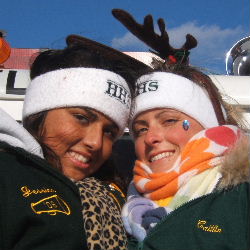
Caitlin Kingston and Jessica Proto, "the pixies," gave it their all yesterday to raise money and collect toys for kids in need.
Words and pictures by Sharon Bass
When a girl becomes a Hamden High cheerleader she winds up rooting for more than just the home team. She finds herself going to bat for the needy as well. Yesterday bore evidence to this when 25 cheerleaders, dressed in green warm-up suits, spent nearly six hours in the Toys R Us parking lot -- in the windy cold -- to collect money and holiday gifts for other children.
The cold, they said, paled in comparison to their burning desire to make kids who don't have much happy.
.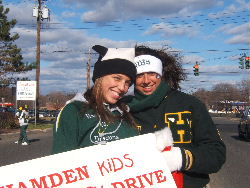
Self-described best friends Amanda Morgillo (left) and Gina Martino, cheerleaders with a mission.
"We've been getting a lot of money so it's really worth it," said Gina Martino, senior co-captain.
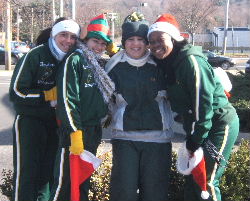
A quartet of good doers: (left to right) Nicole Ferrara, Marissa Barletta, Alicia Liguori and Misty Jones.
"It's very cold," said Alicia Liguori. Finishing her sentence, Misty Jones piped in, "But it's helping out kids and our community and we love it."
Such summed up the sentiment of the ninth annual "Hamden Kids Holiday Toy Drive," a combined effort of the cheerleaders and the town's Community Services Department. Cheerleading coach Chris Wilson and Gretchen Ferri of Community Services coordinated the fund-raiser. And a handful of Hamden cops and firefighters were on the scene for protection and recognition with two big fire engines and a police car.
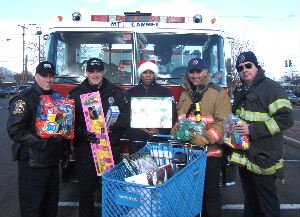
The guys: (left to right) Police Officers Scott Levenduski and Stephen Rossacci and firefighters Danny Mota, Jeff Woodford and Lt. Tim O'Flynn.
"Donations! Donations!" the cheerleaders cried to drivers-by. The girls were in constant motion to ward off the low temp.
"It's worth it standing out here in the cold," said Marissa Barletta. Again a buddy finished another's sentence -- "helping kids out," said Nicole Ferrara. And the girls giggled.
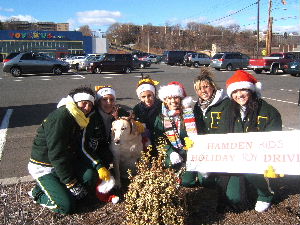
Group huddle: (left to right) Lauren Ercolano, Bethany Potenziani, Riley Michael Panaroni, Brittany Panaroni, Stephanie Colella, Alyssa D'Andrea and Jordyn Mastroianni.
At the end of the day, said Wilson, the cheerleaders pulled in nearly $1,200 and lots of new toys. They will be distributed to parents and guardians on Friday, along with donations from other town toy drives, at the Keefe Community Center.
--------------------------------------------------------------------------
For the Haves

Inside the Lynn residence at 14 Hunters Way, all dolled up by Flowers From the Farm.
Story and photos by Sharon Bass
While Hamden High cheerleaders froze their fannies off collecting toys for the poor, the wealthy opened their finely decorated-for-the-holiday homes to visitors. At no expense to the six homeowners who participated in the "Holiday Home Tour" yesterday, local florists did their abodes up.
The event was sponsored by the Hamden Chamber of Commerce and Calcagni Associates Real Estate. People were charged $20 a head for advance tickets, $25 at the door, to get a peek at how the rich live. Proceeds go to the Hamden Education Foundation.

Holiday plants, by Juliet's Flowers & Gifts, adorn the master-bedroom jacuzzi at the Newman homestead.
Showcased were the Fiss 1931 colonial at 236 Edgehill Road (Window Box), the Lynn Connecticut granite home at 14 Hunters Way (Flowers From the Farm), the Newman stone ranch at 50 Hill Top Road (Juliet's Flowers & Gifts), the Coughlin 1990 Tudor at 14 Guenevere Court (Glen Terrace), the Bonadies contemporary colonial at 21 North Woods Road (Lucian's Greenhouse) and the Schmidt Tudor at 50 Birchwood Drive (Hamden Florist).
----------------------------------------------------------------
For the Holidays
Mayor Henrici and Hamden's First Lady Lauren look over the crowd to watch the lighting of the town Christmas tree.
Words and pictures by Kirsten Walker
The weather outside was frightful
The crowds and songs delightful
Dixwell was the place to go
And it glowed and it glowed and it glowed.
Yesterday felt like old man winter was in the crowd but the warmth of the festivities kept everyone cozy. It was the town tree lighting. After a countdown led by Mayor Craig Henrici -- coached by Arts Commission Director Mimsie Coleman -- the big woody plant across from Memorial Town Hall was aglow. Christmas carols were sung and the siren from a fire truck heralded the arrival of the jolly man in the bright red suit.
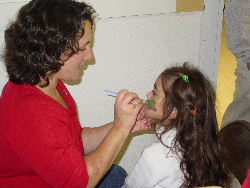
Carla Rousseau face painting in the rotunda of Memorial Town Hall.
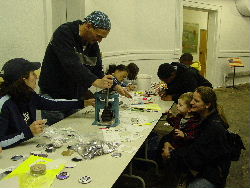
Button making in the rotunda.
Inside a gaily decorated old Town Hall, kids queued to greet Santa. Members of Hamden's Rotary poured cider and handed out treats. Carla Rousseau painted faces. And the holiday season was officially ushered in.
Freddie Saves the Mrs.
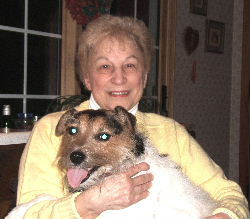
Mary-Nell Valintas holding her little savior, Freddie.Photo/Sharon Bass
By Sharon Bass
Freddie was fixing to dine on turkey and carrots and peas. But he had to wait. First, his "grandparents" had to do a little boasting about him.
So the 30-pound, 6-year-old, hyper Jack Russell terrier shredded a 12-pack beer box with his teeth while the story of how he saved his "grandma's" life was told.
It was the night before Thanksgiving. Larry Valintas went to bed around 9 p.m. as he usual does. His wife, Mary-Nell Valintas (aka grandma), was staying up to watch the UConn men's basketball game, which started at 10. The couple lives on Gaylord Mountain Road.
"I remember at 9:30 in the evening I was getting low," said Mary-Nell, 73, who has insulin-dependent diabetes. She tested her blood sugar level, which was 54 (normal range for a diabetic is 70-140), and then walked toward the kitchen to get something to eat to raise her blood sugar.
"Apparently I went into the living room and that's all I remember," said Mary-Nell.
"I went to sleep and the dog jumped up (on the bed)," said Larry. Some time later, he said, Freddie went into the living room and barked and barked. Larry called out to his wife to see what was going on. But she didn't respond.
"I walked in there and she was on the ground and he (Freddie) was down there looking at her and barking at her," said Larry. Mary-Nell was unconscious. He retrieved a glucose stick and put it in her mouth. "But she was too far gone so I called 9-11."
Paramedics were first to arrive. They gave Mary-Nell intravenous glucose.
"She started to wake up," said Larry. And she wanted to stay at home.
But her blood sugar had plummeted to an almost unheard of nine. She was taken to the Hospital of St. Raphael, where she had worked as a registered nurse for 35 years, and was discharged at 3:30 a.m.
"Freddie saved my life. My husband was in there sleeping," said Mary-Nell, whose daughter Mary-Nelle Valintas is an accounting clerk in Hamden's Finance Department. (That's not a typo; her daughter's name is identical except it has that extra "e.")
"I always have loved him. I talk to him during the daytime like a person," said Mary-Nell.
"He's a good puppy," said Larry.
Freddie is actually Mary-Nelle's dog. But he lives with his "grandparents" since Mary-Nelle is not allowed to have pets in her apartment.
He's not your everyday pooch. His granny and grandpa brag that he's the smartest thing around. They feed him a human diet. His staples are cabbage, corn, broccoli, boneless, skinless chicken breast, veal cutlets, lamb and cantaloupe.
"He eats apples off the tree. He'll eat tomatoes, too, off the vine," said Larry. "For happy hour, he has popcorn and a little potato chip."
"He likes beer," added Mary-Nell. And at 9 o'clock every night, Freddie and Larry have a nightcap together. Larry downs a cold glass of milk with a Drake's cupcake. And Freddie gets a Milk Bone. It's probably a good reminder to the precocious boy that despite his human lifestyle he is a dog. And a lifesaving one at that.
Good boy.
Site designed by Joanne Kittredge

Tip Us Off
Send
news tips


